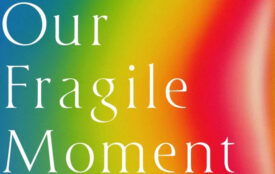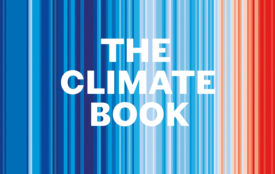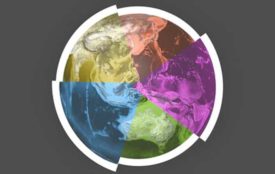Global Environmental Politics
Planet Earth in trouble. More on the need for effective global environmental politics. A review by Professor Udo E. Simonis.
This is a valuable, authoritative, and extraordinary book. Until the 1980s, the authors say, most governments regarded global environmental problems as minor issues, marginal both to their specific national interests and to international politics in general. But then the situation changed. The rise of environmental movements and the appearance of well-publicized environmental threats and well-documented environmental damages awarded global environmental issues a higher status in world politics. Today, the authors suggest, environmental issues are viewed as internationally important both in their own right and because they affect other crucial aspects of world politics, like development, trade, social issues, and international security (chapter 1).
Global environmental politics then is a consequence of the growing awareness of limits, of stress on and damage to natural resources and ecological systems, but also of limits of national policies and strategies. Understanding global environmental politics however requires understanding international regimes. It is this concept, the authors focus on: a regime as a system of principles, norms, rules, operating procedures, and institutions that actors create to regulate and coordinate action in a particular issue area of international relations.
Environmental regimes are essentially policy, regulatory, and administrative systems. But who are the actors? Although states, as the dominant actors in the international system, are the primary and most important makers of international regimes, they are not at all the only actors involved in their formulation or implementation. International organizations, non-governmental organizations, multinational corporations and even private individuals do also play a role, though this playing is not always going in the same direction (chapter 2).
On this basic understanding, the authors investigate the development of, and the challenges faced by, ten prominent cases: the regimes on ozone depletion, hazardous wastes, toxic chemicals, and climate change (in chapter 3), on biodiversity, whaling, trade in endangered species, fisheries, desertification, and forests (in chapter 4). Each of these sectors of established global environmental policy is analyzed according to the state and change of negotiations, and their respective results. This is conceptually and empirically the most valuable part of the book. But here comes in a first flaw. Several global environmental problems are not being addressed, for instance, the water problem which both quantitatively and qualitatively poses threats to an increasing number of people around the world. Probably, this is due to the regime definition chosen. There are environmental problems that are global in character, and there are others that are (only) ubiquitous. So far, no global water policy institution exists; there is no United Nations convention on water, although policy goals have been defined and measures to address the problem were undertaken.
Anyhow, the special attention of the authors is on the effectiveness of the existing ten environmental regimes. What are the obstacles, and what are the opportunities for global environmental policy to be successful? A huge number of factors are exemplified here (in chapter 5), and one special lesson is being drawn: environmental regimes should not only be ratified, they should permanently be improved. “Parties can strengthen the regimes by tightening the requirements for regulating activities that are causing environmental disruption or resource depletion” (p. 282). A nice anodyne – the evening crowns the day!
The authors’ optimism, it seems, lies particularly in the characterization of the state actors, and their flexibility: There are leading states, supporting states, deciding states, and veto states – they say. But, depending on interior constellations, the one could become the other. And those interior constellations are substantially stamped by non-governmental organizations (NGOs), and in some cases even by individuals, like prominents, philanthrops or social entrepreneurs.
Optimism – all over. But where then are the weaknesses of the book? Well, the authors are all Americans. And often, Americans do not catch what is thought or do not trust what is happening elsewhere in the world. For instance, the role of the European Union in global environmental politics is largely under-exposed. Not one of the valuable reports of the European Environmental Agency (EEA) was used for the book, not one of the many reports of the German Advisory Council on Global Change (WBGU). Also, the potentially important role of the Small Islands States in climate policy, nor the role of China and India in materials policy are adequately contemplated. And even the issue of policy integration is not well addressed, although the authors do occasionally deplore the fragmentation of the various global environmental regimes and policies.
Integrating the fragmented, sectoral views of environmental politics seems to be especially necessary as ecosystems are truly interdependent, as climate change impacts biodiversity, and biodiversity impacts forests or soils – and vice versa. And also because global environmental policy must find better feed-backs with other policies, above all but not only with those of the World Bank (WB), the International Monetary Fund (IMF), and the World Trade Organization (WTO).
In this way, it seems, the authors let slip the central issue of the great asymmetry between the economic and the environmental interests in this world. On the one hand, they state “…that economic health depends on social and ecological health” (p. 319), that economy and ecology are interdependent. On the other hand, they satirize the efforts made by many authors to establish a Global Environmental Organization (GEO) which – in analogy to the World Health Organizaion (WHO) or the World Trade Organization (WTO) – could impose binding decisions on their members or sanctions on ecological misbehavior.
Readers especially interested in development politics also could find some reasons for disappointment, or better, for some further improvement. Global environmental damages – not only climate change – will, no doubt, affect the poor developing nations most. In consequence, future environmental policy has to take care of both the global environmental problems and the problems of poverty and exploitation in the developing countries.
To be honest, the authors have done a lot to connect environmental politics and sustainable development (chapter 6). And in their outlook to the future of global environmental politics (chapter 7), they address the transition from the “Millennium Development Goals” to the prospected “Sustainable Development Goals”. Still, the reviewer would have preferred to be shaked up or even provocated on the issue of equity and fairness in international relations. Hopefully, the next edition of the book will make this a major issue.
The authors end their book on global environmental politics with a prediction: “What the future will bring is unclear. There are reasons for both optimism and great concern. The need for innovative and creative global solutions is greater than ever” (p. 339). No doubt, on this point the authors are absolutely authoritative.
Source
Professor Emeritus für Umweltpolitik am Wissenschaftszentrum Berlin (WZB) und Redakteur des Jahrbuch Ökologie








